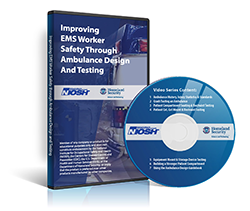Behind the Wheel at Work

Behind the Wheel at Work is a quarterly eNewsletter bringing you the latest news from the NIOSH Center for Motor Vehicle Safety.
Volume 2 Number 2 June 2017
All Things Safety
Back to basics. In recognition of National Safety Month, we’re covering different ways to incorporate motor vehicle safety in the workplace – education, policy, leadership, communication, and data, to name a few. Access previous issues of our newsletter.
Why we’re smiling at the Center for Motor Vehicle Safety

At the Center for Motor Vehicle Safety, nothing makes us happier than seeing progress towards our goal: keeping workers safe on the road. And we have many reasons to be proud.
Recently, many of our team members have been recognized for their efforts towards this goal.
CMVS staff Rebecca Olsavsky, Sydney Webb, and Stephanie Pratt received an Award of Distinction at the 2017 ClearMark Awards ceremony, held at the National Press Club and hosted by the Center for Plain Language. The award-winning Keep Workers Safe on the Road infographic, which was nominated in the “Original Documents – Short” category, covers the human and economic impact of work-related crashes.
We are also excited to congratulate CMVS staff recognized at the NIOSH Science Awards:
- Bullard-Sherwood Research to Practice Award, Winners: Kyla Retzer, Ryan Hill (Knowledge); Claire Caruso, Ted Hitchcock (Intervention)
- Alice Hamilton Awards for Excellence in Occupational Safety and Health, Honorable Mention: Stephanie Pratt, Rosa Rodríguez-Acosta (Epidemiology and Surveillance); Jennifer Lincoln, Karl Sieber, Guang Chen, Ted Hitchcock (Exposure and Risk Assessment)
Safety tip for employers!
Prepare workers before implementing distracted driving policies by communicating:
- How distracted driving puts them at risk of a crash
- That driving requires their full attention while they are on the road
- What they need to do to comply with your company’s policies
- What action you will take if they do not follow these policies
Cheat sheet: Road safety observances

Remember when we shared a road-safety-resource cheat sheet? Here’s another quick reference guide to promote road safety at work. Consider engaging your workers in the following safety observances via Twitter, posters, email, or even as a conversation starter during regularly-scheduled meetings.
National Safety Month Focuses on reducing leading causes of injury and death at work, on the road, and in homes and communities.
National Truck Driver Appreciation Week Takes the time to honor all professional truck drivers for their hard work and commitment.
National Employ Older Workers Week Aims to increase awareness of older workers and develop innovative strategies to maximize productivity of this workforce.
Drive Safely Work Week Aims to improve the driving safety of workers and their family members.
National Teen Driver Safety Week Raises awareness of teen driver safety topics and encourages safe teen driver and passenger behavior.
Drowsy Driving Prevention Week Raises awareness about drowsy driving, its effect on drivers, and how it can be avoided.
Older Driver Safety Awareness Week Aims to promote understanding of the importance of mobility and transportation for keeping older adults active and engaged in the community.
Safety Chat: NIOSH & NSC
-
 Dr. Stephanie Pratt is Director of the National Institute for Occupational Safety and Health (NIOSH) Center for Motor Vehicle Safety.
Dr. Stephanie Pratt is Director of the National Institute for Occupational Safety and Health (NIOSH) Center for Motor Vehicle Safety.
-
 Kelly Nantel is Vice President, Communications & Advocacy, at the National Safety Council, a nonprofit organization with the mission of eliminating preventable deaths at work, in homes and communities, and on the road.
Kelly Nantel is Vice President, Communications & Advocacy, at the National Safety Council, a nonprofit organization with the mission of eliminating preventable deaths at work, in homes and communities, and on the road.
Stephanie: The NIOSH Center for Motor Vehicle Safety values opportunities to contribute to road safety initiatives led by the National Safety Council, which are directly in line with priorities identified through a midcourse review of our strategic plan. The first priority, fatigue, has long been recognized as a factor in work-related crashes. Historically, people viewed fatigue as affecting mainly long-haul truck drivers, but research and interactions with employers tell us that’s too narrow a view. All workers who drive can be affected: oil and gas workers with long hours and commutes; health care workers; first responders; and sales workers who cover a lot of territory. Can you tell me more about NSC’s fatigue initiative, and how our Center might contribute?
Kelly: First, thank you for being a great resource and partner for improving motor vehicle safety. We at NSC agree wholeheartedly that anyone can be affected by fatigue, not just long-haul truck drivers. Thousands of people – including those who drive as part of their job, and those who drive to or from work – die every year in drowsy-driving related crashes. Drowsy driving is impaired driving. We encourage employers to use NSC resources to educate themselves and their workers about the dangers of driving while fatigued. Your Center can – and does – contribute to our efforts by making fatigue part of the national conversation.
Stephanie: Recently, we’ve thought more broadly about sources of driver fatigue, including off-the-job factors such as commute length, sleep habits, health status, and medications. We recognize that fatigue can co-exist with other risk factors such as distraction. In fact, the Center is doing research that will help us better understand how fatigue, distraction, and other factors relate. Fatigue is also a topic of discussion in context of highly-automated vehicles, which are on the horizon but decades away from dominating roads. Highly-automated vehicles are a second issue our Center will focus on more in the future, and this is another challenging issue NSC is taking on.
Kelly: Absolutely. And while it might be decades before fully automated vehicles are on every roadway, life-saving technologies already have started to appear in some new vehicles. One such feature is a drowsiness detection system, which monitors a vehicle’s movements and warns the driver with a sound or vibration if it detects the vehicle starting to drift. Researchers are working to develop additional technology that may monitor a driver’s heart rate, eye movements, or breathing patterns. We’re working with NIOSH and others on a committee to develop the ANSI Z15.3 national standard on safe operation of automated fleet vehicles, which will serve as a companion to the recently revised Z15.1 standard, Safe Practices for Motor Vehicle Operations.
Stephanie: The Z15.3 standard will enable us to help employers plan for the safe introduction of automated vehicles, potentially a seismic shift in how we think about managing vehicle fleets. There will be many difficult issues for us to confront as we develop the standard. Just a few examples – which crash avoidance or driver assistance systems we might now be able to recommend based on evidence, changes in how we think about liability, and how to make sure employee drivers are familiar with automated-vehicle features.
Kelly: These are difficult but important issues to tackle, especially given the rapid pace at which vehicle safety technology is evolving. The work of the Z15.3 committee ultimately contributes to a comprehensive effort NSC is leading called the Road to Zero Coalition. The goal of Road to Zero is to eliminate traffic fatalities within 30 years. We know this is lofty, but we think it is attainable thanks to a large, national coalition that includes an incredible group of transportation and technology stakeholders.
Stephanie: It’s been a great opportunity for us – the Coalition brings together so many important communities we’ve not necessarily had a chance to interact with. We particularly value the involvement of tech companies because it can help inform NIOSH’s engineering research on crash avoidance in work vehicles, and in the future, highly-automated vehicles used in the workplace. More broadly, we appreciate that you and your partners in the Coalition recognize the importance of workplace driving for the safety of everyone on the road.
NEW video series: Improving EMS worker safety through ambulance design and testing

NIOSH partnered with Department of Homeland Security’s Science and Technology Directorate as well as other federal agencies and the ambulance industry to develop a 7-part video series that covers new crash test methods. The series highlights changes impacting ambulance design, testing, and manufacture. These changes support efficient patient care and improve safety in the ambulance patient compartment for Emergency Medical Services (EMS) workers, first responders, and their patients. Watch the video series now!
4 tips for communicating with workers about safety
Getting through to your employees about road safety can be tough. Consider using the following tips to improve communication, and learn how NIOSH is using clear communication:
Remove physical barriers.
Nonverbal communication speaks volumes. Visual cues (e.g., body language, distance) are their own language and communicate your impression of a situation. Pull your chair out from behind the desk when meeting with an employee to discuss how they can improve driving performance, or step out from behind the podium while conducting a safety meeting. This simple act will make you more approachable and more likable.
Write how you speak.
Maybe you’ve heard it before: plain language is not “dumbing down.” Only say what you need to say, and say it in simple terms. Pretend you have to pay for each word you use, and big words cost double. Make your road safety policies and educational materials easy to understand by using action verbs, bulleted lists, and short sections centered on a key message. Incorporate short, frequent safety communication into the workday.
Keep it positive.
Say what employees should be doing, rather than focusing on what they should not do. For example, remind drivers to focus on the road when behind the wheel at work, rather than just saying avoid distracted driving. Positive communication is a two-way street. Invite workers to share their thoughts about how road safety in your company could be improved.
Prepare employees for changes, and follow through.
If you’re going to change a policy or introduce a new program, explain to employees in advance how it works and what it’s intended to accomplish. Once the policy or program is in place, ask employees for feedback and let them know about any changes you’ve made.
Fatigue causes & effects
More than 16% of fatal crashes involve a drowsy driver, and more than one in three workers report being sleep-deprived. The National Safety Council has a new video that managers can use in safety trainings to help workers understand the causes of fatigue and how it affects their driving.
![]() Please send your comments and suggestions to us at kur4@cdc.gov.
Please send your comments and suggestions to us at kur4@cdc.gov.
Subscribe to Behind the Wheel at Work
Enter your email address to receive research updates, links to motor vehicle safety resources, practical tips on workplace driving, and news about upcoming events.
- Page last reviewed: June 22, 2017
- Page last updated: June 22, 2017
- Content source:
- National Institute for Occupational Safety and Health Division of Safety Research


 ShareCompartir
ShareCompartir
